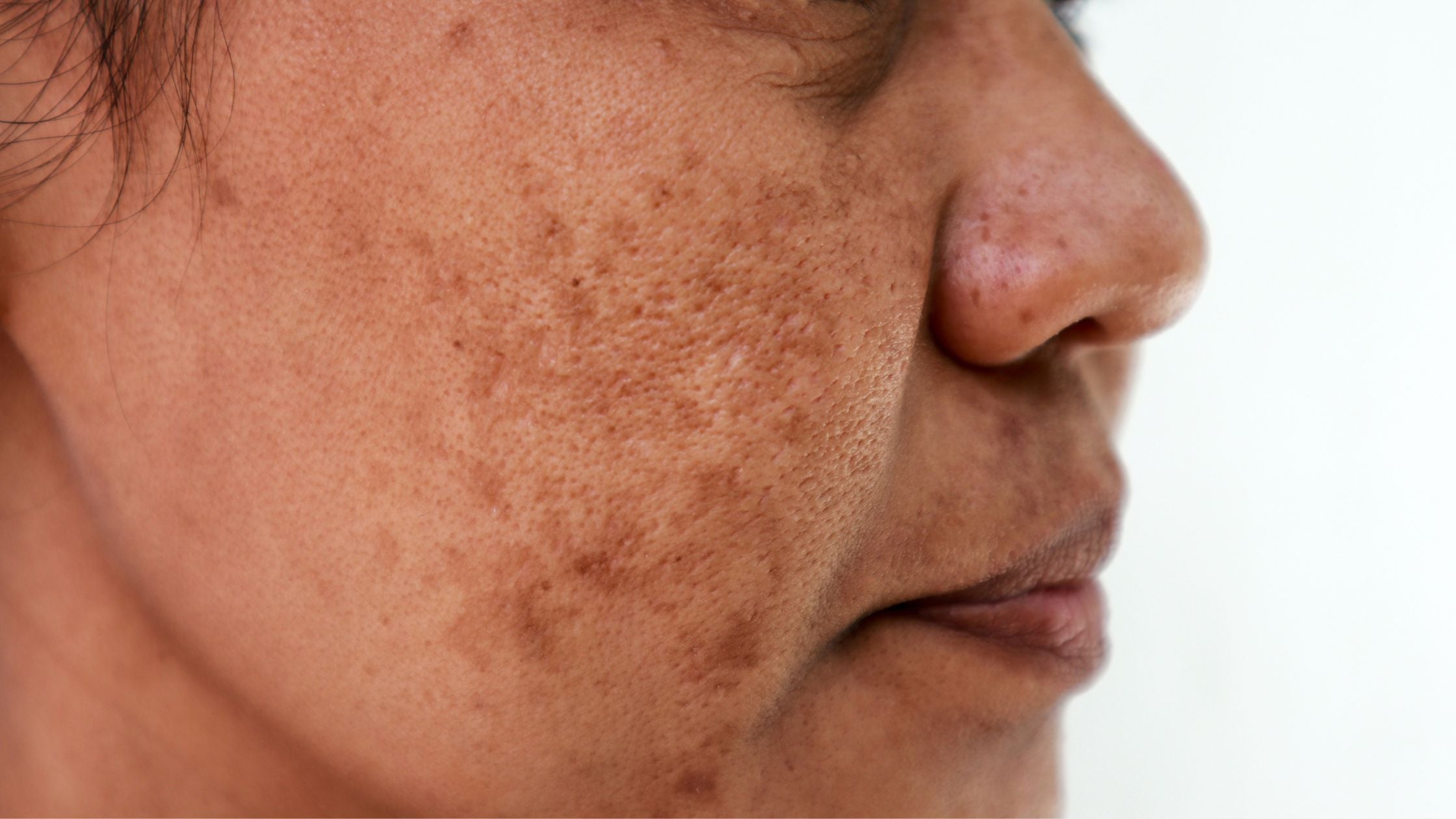How to Get Even Pigmentation: Hydroquinone May be the Key

Most people think about the presence or absence of acne when they refer to someone’s complexion. But dyschromia goes hand in hand with a lot of complaints that people have about their skin. Dyschromia is a broad term for when the color of the skin is not even. Dyschromia is generally not painful and in a lot of cases, such as freckles, it’s a normal part of someone’s appearance.
What is dyschromia?

Dyschromia is skin discoloration and usually occurs in patches. Melanin is the brown pigment in our skin and the amount we have is determined by genetics. But, it gets deeper depending on the sun (like in a tan), but things like heavy metals, hormonal changes, and radiation can cause temporary or permanent increases or decreases in pigment production.
Hyperpigmentation is more commonly known- this is an increase in melanin production. But the reverse, called hypopigmentation, a decrease in melanin production, occurs as well.
Dyschromia is the blanket term for common things such as:
-
Melasma
-
Chloasma
-
Solar lentigines (sun spots)
-
Freckles
-
Birthmarks
Looking at that list, you may see that you probably have some form of dyschromia. It’s normal, usually harmless and very common!
Dyschromia can also result from the healing process of wounds and skin infections where discoloration remains. This is also called post-inflammatory hyperpigmentation. If you’ve ever had a colored spot that remains after a pimple is long gone, that’s a form of post inflammatory hyperpigmentation.
Radiation therapy can also cause dyschromia.
Treating Hyperpigmentation
Even though most forms of dyschromia are harmless, they can still make a person self conscious about their appearance. Since hyperpigmentation (too much melanin in patchy areas) is generally more common and easier to treat, we will focus on that.
Melasma is one example of hyperpigmentation that can affect someone’s self esteem. Dark patches on someone’s face, especially dark skin on the upper lip, can be unattractive to many people, especially on women. Make up can help, but choosing the right shade can be a chore. Then the user has to blend and retouch throughout the day.
The good news is that there are treatments for hyperpigmentation. The most common is a prescription ingredient called hydroquinone.
Hydroquinone is the Gold Standard
Hydroquinone is a skin lightening agent. It bleaches the skin by reducing the number of melanocytes. Melanocytes make melanin, which is what produces the brown pigment in your skin. By controlling these melanocytes, your skin will become more evenly toned over time.
Hydroquinone is used to treat a variety of hyperpigmentation issues:
-
Melasma
-
Age spots
-
Freckles
-
Acne scars
-
Post inflammatory hyperpigmentation caused by eczema or psoriasis
Hydroquinone can help with discoloration from inflammation that has healed, but will not treat active flare ups. For example, it will treat hyperpigmentation from acne scars, but not discoloration from active acne.
It takes about four weeks for the effects of hydroquinone treatment to be seen and several months to get the full effect.
Hydroquinone tends to work best on fair skin tones because it lightens the darker areas of the skin. If you have darker skin, you will want to talk to your dermatologist before using the product, as it could make hyperpigmentation worse.
One of the most common side effects from hydroquinone is redness and dry skin. These side effects do get better as your skin gets used to it. Moisturizing is crucial when using this product! It can also make skin more sensitive to the sun, so use sunscreen (as you should be anyway!).
There are rare cases of hydroquinone causing a condition called ochronosis. Papules and bluish-black pigmentation occurs. This usually happens after you’ve been using the product for several months. That said, it is only recommended to be used for five months at a time.
How to Use Hydroquinone

Because hydroquinone has some side effects, your best bet is to try a patch test before using it. To do this, put a little bit of the cream inside of your forearm then cover it with a bandaid. After 24 hours, if you experience severe itching, hydroquinone might not be for you. If you don’t experience any side effects it should be safe for you to use.
-
Cleanse and dry your skin.
-
Use a small amount to hydroquinone cream and apply it all over your face. Massage until fully absorbed.
-
Wash your hands!
-
Apply moisturizer.
-
If daytime, apply sunscreen.
If you use other products or serums, talk to your doctor or consult the instructions that come with your skincare regimen to see what order to apply things. Obviously sunscreen will always go last!
Where to Get Hydroquinone
Hydroquinone is available with a prescription, so you will need to consult with a healthcare provider. It can interact with other medications or worsen certain health conditions, which is why a prescription is required.
Qyral has now made a dermatology consultation convenient, easy, and inexpensive! Simply fill out our skin assessment, snap a couple of quick photos, and we’ll do the rest. We work with a team of board certified dermatologists who can look at your health history and make a visual diagnosis of your skin. They will then prescribe the best products available to get you started on the path to the most beautiful skin you’ve ever had! When you purchase any of our prescription Qyral+ products, you’ll be charged an annual fee of less than $50. Your prescription is good through Qyral for the next year and you’ll have access to a dermatologist for any questions related to our products!
Learn more about our new Qyral+ line at qyral.com!